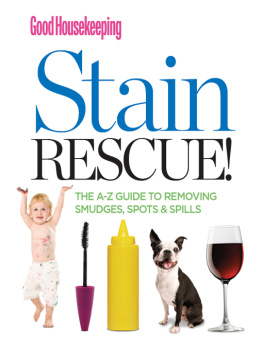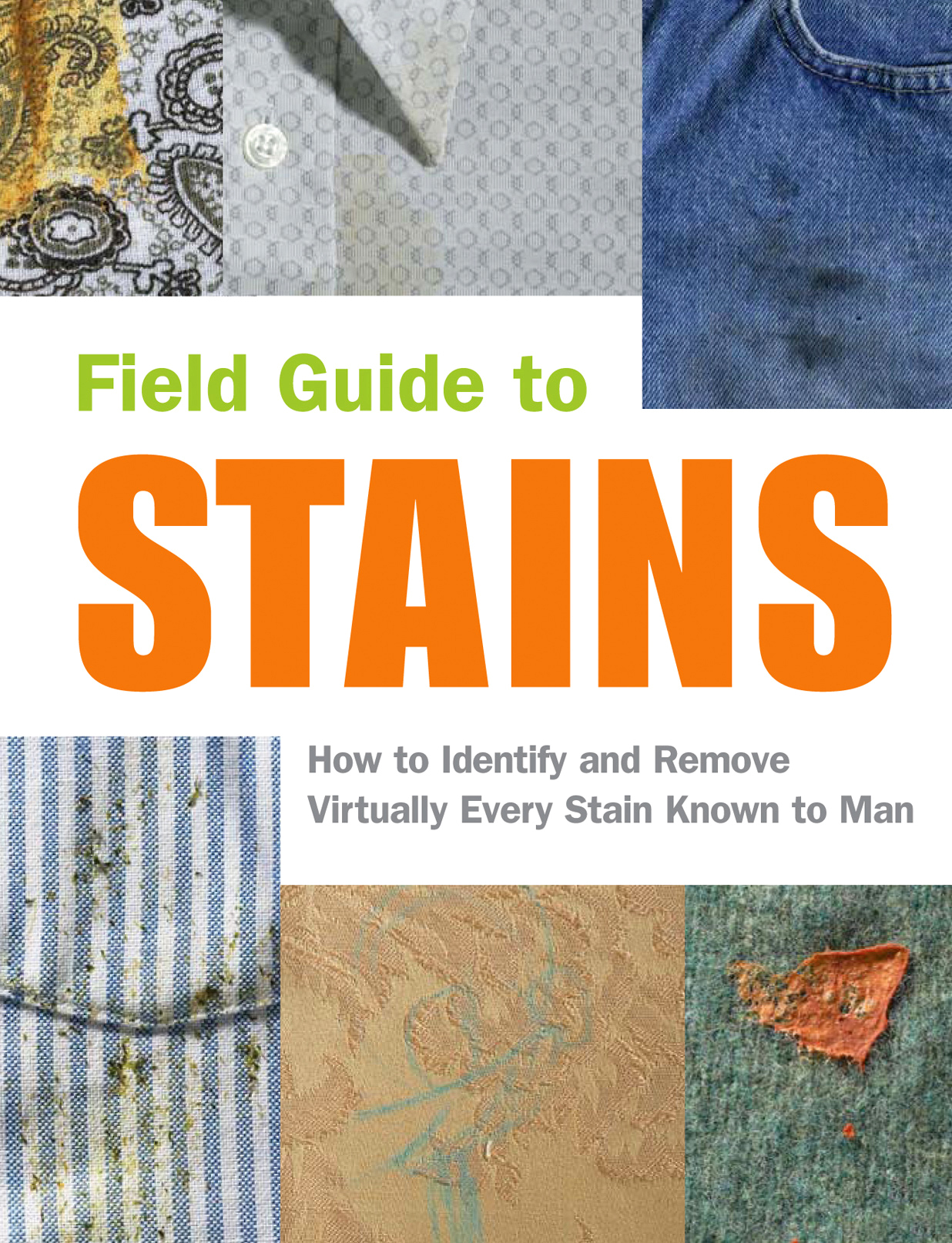DISCLAIMER
Stains come in all shapes, sizes, and types, and addressing all possible variables when recommending removal tips is difficult. While every care has been taken to test the effectiveness of the information in this book, the author and publisher cannot guarantee results nor take responsibility for any damage resulting from any stain removal method.
Copyright 2002 by Quirk Productions, Inc.
All rights reserved. No part of this book may be reproduced in any form without written permission from the publisher.
Library of Congress Cataloging in Publication Number: 2002104065
eBook ISBN: 978-1-59474-850-9
Trade Paperback ISBN: 978-1-931686-07-5
Trade Paperback designed by Susan Van Horn
All photographs copyright 2002 by Quirk Productions, Inc.
Quirk Books
215 Church Street
Philadelphia, PA 19106
quirkbooks.com
v3.1
Contents
Introduction
Whoever coined the phrase good, clean fun obviously wasnt thinking of eating a rocky-road ice-cream cone while wearing a white T-shirt on a hot, summer day. Fun is often synonymous with messy, and this book is written for fun-loving people such as yourself. Field Guide to Stains is the perfect companion for those of us whove ever had lapses of eye-hand coordination at the dinner table, in the garage, bathroom, or elsewhere. We may not be able to teach you grace, but perhaps we can help keep you a little cleaner.
With tips on how to remove more than 100 spills and smudges, this is the ultimate book on filth and how to get rid of it. Most stains dont talk, so weve included tips on how to identify an array of spots. Turn to the sections How to Identify Your Stain and the Color Guide to Stains to start playing the elimination game. Once youve determined the culprit, locate the stain removal method in the Field Guide , which is conveniently organized by the sources of stains: Fruits and Vegetables, Meat and Protein, Dairy Products, Sauces and Condiments, Office and School Products, and so forth. You get the idea. Even Lady Macbeth and Monica Lewinsky could find solutions to their damned spots. If youre uncertain about specific terms or products mentioned in the book, look them up in the Glossary in the back of the book. We told you this was comprehensive, didnt we?
And if all else fails, prop the book up under your chin before that next bite of lasagna!
Use the for an at-a-glance guide to typical stain seasons, areas of occurrence, and removal techniques.
Stain Removal Tips
Read garment labels before treating any stain.
Use cleaning products according to manufacturers labels.
Apply stain removers and solutions to the back of a stain; this will push the stain out of the fabric instead of into it.
Treat the stain until it is removed, then discontinue treatment.
Do not apply any kind of heat (including ironing and using the dryer) until you are certain that the stain has been removed. Heat will often set a stain and make it difficult to remove. Instead, allow garments to air dry, then treat again, if needed. Drying stained garments in sunlight is best; it provides some mild bleaching.
Testing for colorfastness is recommended before using any kind of bleach or strong cleaning product. To test, apply the cleaning agent to an inconspicuous area of the garment, such as an inside seam. Steps that include bleaching and may require such a test are indicated in the margin by the universal symbol for bleach, a triangle.
If you have to take a garment to the dry cleaners, point out the stain and explain what it is so that it can be treated accordingly.
Make sure that flammable materials such as turpentine and acetone are completely rinsed from a garment before putting it in the dryer.
How to Identify Your Stain
Take the guesswork out of stain identification by asking yourself the following questions:
When did I last wear this? Narrowing down the time and place where the stain was acquired will help you figure out just what was spilled.
How could the stain have happened? Did you sit in it, brush against it, or maybe scuff it with a pant leg? Connecting cause with effect is essential; often, placement of the stain will help identify those mysterious ones.
What color is it? One of the easiest ways to identify a stain is by its color. But be aware, some stains react differently to different-colored fabrics, while some, like oil, appear colorless at first but darken as dirt clings to them. For help identifying possible sources of colored stains, see the first pages of the color section.
What does this smell like? Some stains, like alcohol, fruit juices, or motor oil, have unmistakable odors, especially before washing.
Color Guide to Stains
Stains and colors go hand in hand, and determining your culprit is sometimes simply a matter of color identification. Refer to this chart to find the top five items in each stain color.
 RED RED |  GREEN GREEN |
| Blood | Broccoli |
| Fruits or Berries | Grass |
| Ketchup | Relish |
| Salsa | Spinach |
| Vinegar | Vomit |
 ORANGE ORANGE |  BLUE BLUE |
| Barbecue or Steak Sauces | Fruits or Berries |
| Carrot | Ink, all types |
| Potato, Sweet | Paint, all types |
| Rust | Toothpaste |
| Sap | Windshield Wiper Fluid |
 YELLOW YELLOW |  PURPLE PURPLE |
| Adhesives or Stickers | Cabbage, Red |
| Beer | Fruits or Berries |
| Mustard | Jam or Jelly |
| Pollen | Onion, Red |
| Sweat | Wine, Red |
 PINK PINK |  CLEAR/TRANSLUCENT CLEAR/TRANSLUCENT |
| Gum | Dairy Products |
| Lipstick | Gasoline |
| Medicine | Oil, all types |
| Wax, Candle | Ointment |
| Yogurt | Wine, White |
 BROWN BROWN |  WHITE WHITE |
| Chocolate | Correction Fluid |
| Coffee | Deodorants or Antiperspirants |
| Dirt or Mud | Glue |
| Iodine | Lotion, Hand or Body |






 RED
RED GREEN
GREEN ORANGE
ORANGE BLUE
BLUE YELLOW
YELLOW PURPLE
PURPLE PINK
PINK CLEAR/TRANSLUCENT
CLEAR/TRANSLUCENT BROWN
BROWN WHITE
WHITE